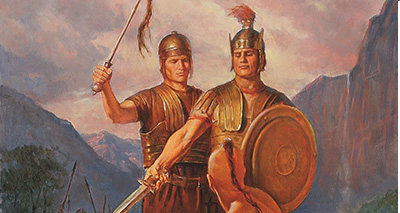
“You’ve seen the play, now read the book.” The ad, plastered on taxis, was for the Broadway play The Book of Mormon. Latter-day Saints, more commonly known by their nickname “Mormons,” are a global faith that started in America. It is growing, with 17 million people now on the rolls. Among its members are former presidential candidate Mitt Romney, Kansas City Chiefs coach Andy Reid, Hall of Fame NFL quarterback Steve Young, and Brandon Flowers, lead singer of The Killers. I grew up in Idaho, right next door to Utah, and many of my classmates, friends, and neighbors were either current or former Mormons.
When people think of Latter-day Saints, they imagine young men on bikes with white shirts and ties who knock on your door. Anyone familiar with Mormons knows they have peculiar beliefs and customs about what they can’t drink, what they wear under their clothes, and their large families. One of the little-known aspects of their theology, taught from their origin and found within their holy books, is the importance of race.
As a young boy, I read the holy books of many religions. Some lightly touch on race or at least infer its significance or origin, but I haven’t read a holy text that is as explicit or as balanced on race as The Book of Mormon. I’ll give many examples, but first, it’s important to understand the context of the book, its story, and its alleged origin.
Joseph Smith, the founder of the Latter-day Saint religion, was born in the early 1800s in Vermont and later moved with his family to upstate New York. As a young man, Smith claimed to have received divine manifestations from God, as well as visits from angels. One such manifestation was from an angel who visited one night in the autumn of 1823. This angel said he was once a mortal man who had lived on the American continent. He claimed to belong to a people who were not the American Indians but had lived alongside them. He said his nation descended from a group of fair-skinned pilgrims who fled Palestine to escape the conquest of the Babylonians roughly 600 years before the birth of Christ.
Smith claimed this angel told him many things about this fair-skinned, ancient people, including their way of life, government, and agriculture. However, the main reason this angel had come to him was to tell him that there were important documents about the history of this people, and that God wanted Smith to have them and publish them. Future generations could read the story of their downfall as a warning to avoid a similar fate.
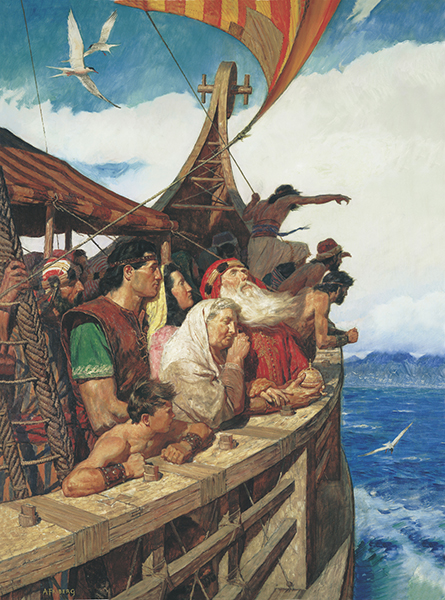
Lehi, the patriarch and initial leader of the white-skinned pilgrims who fled Palestine around 600 BC, arriving in their ships in America.
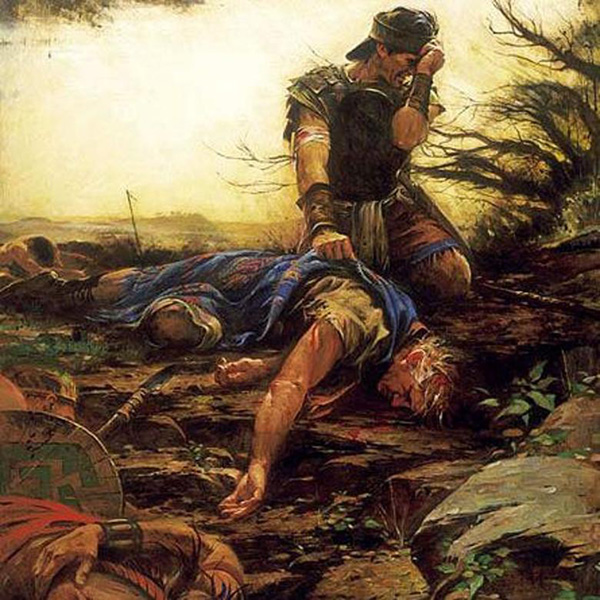
Mormon’s son grieves over him after he died in battle with American Indians, referred to as “Lamanites.” This is the general term for dark-skinned people seen as outsiders by the white tribes.
The being who appeared to Smith said that his father, Mormon, entrusted him with a detailed account of their people’s story. This is how the book gets its name.
Not long after these fair-skinned people arrived in America, they were split by God into two racial groups, with one becoming dark skinned, and the ancestors of the American Indians. The white people were in chronic conflict with the ancestors of the American Indians. Most of The Book of Mormon is about the thousand years of strife between these two groups. Eventually, the Indians exterminated the whites.
Mormon was a soldier who fought in these wars, but he was also a scholar with a deep love for his people and culture. Even if they were to perish, Mormon wanted their story to survive. He compiled parts of their writings, and to ensure their durability, engraved them on metal sheets bound with metal rings, and gave them to his son. The son told Smith that he himself had been hunted for many years by Indians before he died, and that he had buried the documents in a hill not far from Smith’s house. Smith claimed he was led to the hill, where there was a rock that, when moved, revealed what appeared to be a man-made stone enclosure.
Inside were the metal sheets bound at the spine with rings, like a book. In the enclosure, he also claimed to have found a sword, a breastplate, and what could be described as translucent spectacles.

The angel appears to Joseph Smith.

Joseph Smith on what was locally called “the Hill Cumorah” in upstate New York, not far from his family farm. He is moving the stone in order to enter the cement, where the relics and tablets were stored.
The book was written in what Smith called “Reformed Egyptian,” and with the “gift and power of God,” he translated it into English. It reads like the Christian Bible, and includes instructions on prayer, fasting, repentance, and God, but there are many interesting passages about race.
Specific passages
Nephi was in the initial group of pilgrims who fled from Palestine. He is described as a very pious man who has many supernatural experiences. In a vision, which Mormon explains was very important, Nephi saw that his people would not survive, but many years later, another white people would inherit the land. A European would set out upon the waters, find this continent, and others would follow:
I looked and beheld a man among the Gentiles [often interpreted as Columbus], who was separated by the many waters; and I beheld he went forth upon the many waters, even unto the seed of my brethren. And it came to pass that I beheld many multitudes of the Gentiles upon the land of promise; and they [the Indians] were scattered before the Gentiles and were smitten. And I beheld the Spirit of the Lord, that it was upon the Gentiles, and they did prosper and obtain the land for their inheritance; and I beheld that they were white, and exceedingly fair and beautiful, like unto my people before they were slain. (1 Nephi 13:15)
The Book of Mormon retells the Tower of Babel, in which God scattered humanity to different parts of the earth by causing them to speak different languages. Race seems to be the way the Creator separates nations and defines boundaries. The Book of Mormon suggests that race is how populations have been divinely separated into their nations and groups, and this dispersion begins the migration that eventually leads to the Americas.
In Old Testament tradition and in the Abrahamic faiths, there was strict endogamy — marrying within one’s tribe and people. In the Law of Moses, the Israelites were banned from intermarrying with Canaanites or foreigners because if they married people from foreign cultures with foreign customs and gods, they might lose their identity. To reinforce this point, in the Law of Moses, Israelites were not allowed to mix different materials when weaving cloth, they couldn’t have different species of animals pulling carts together, and segregation and boundaries were common.
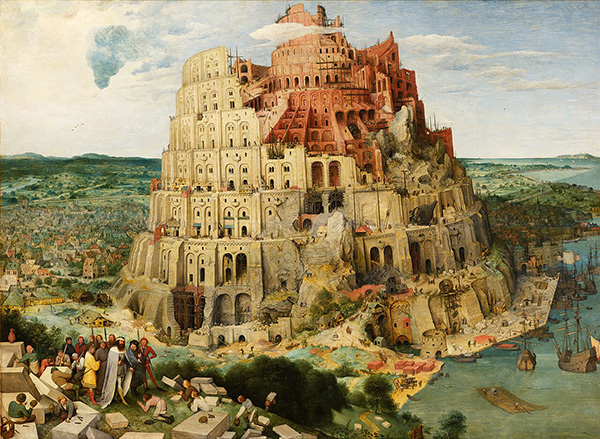
Peter Bruegel’s The Tower of Babel
The Book of Mormon and other LDS holy books teach that all human beings descend from Adam and Eve, but because American Indians rebelled against God, he turned them dark. This makes them unattractive to white people and discourages mixing:
[God] had caused the cursing to come upon them, yea, even a sore cursing, because of their iniquity. For behold, they had hardened their hearts against him, that they had become like unto a flint; wherefore, as they were white, and exceedingly fair and delightsome, that they might not be enticing unto my people, the Lord God did cause a skin of blackness to come upon them. And thus saith the Lord God: I will cause that they shall be loathsome unto thy people, save they shall repent. And cursed shall be the seed of him that mixeth with their seed; for they shall be cursed even with the same cursing. (2 Nephi 5:21)
And their skins (American Indians) were dark, according to the mark which was set upon their fathers. This was done that their seed might be distinguished from the seed of their brethren, that thereby the Lord God might preserve his people, that they might not mix and believe in incorrect traditions which would prove their destruction. And it came to pass that whosoever did mingle his seed with that of [Indians] did bring the same curse upon his seed. Therefore, whosoever suffered himself to be led away by the [Indians] was called under that head, and there was a mark set upon him. (Alma 3:6)
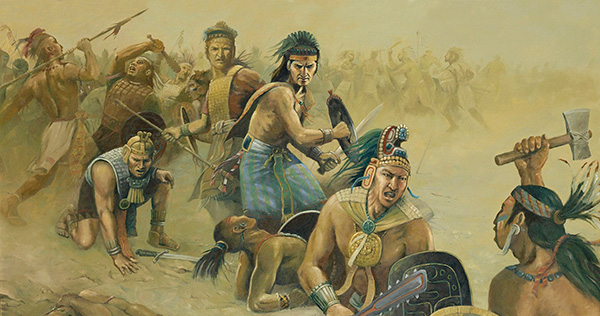
Warfare between the white-skinned and dark-skinned races. American Indians are depicted without armor, sometimes fighting with shields, clubs or axes. Whites often wear armor and fight with swords and spears.
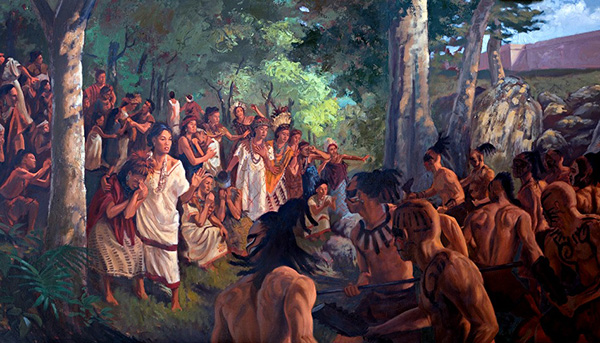
Dark-skinned American Indians.
These are similar passages, though not in The Book of Mormon, in what Latter-day Saints refer to as The Pearl of Great Price, which Joseph Smith claimed included writings of Biblical figures such as Moses, Enoch, and Abraham. These passages also discuss race.
Enoch also beheld the residue of the people which were the sons of Adam; and they were a mixture of all the seed of Adam, save it was the seed of Cain, for the seed of Cain were black, and had not place among them. (Moses 7:21)
Behold the people of Canaan, which are numerous, shall go forth in battle array against the people of Shum, and shall slay them that they shall utterly be destroyed; and the people of Canaan shall divide themselves in the land, and the land shall be barren and unfruitful, and none other people shall dwell there but the people of Canaan. For behold, the Lord shall curse the land with much heat, and the barrenness thereof shall go forth forever; and there was a blackness that came upon all the children of Canaan, that they were despised among all people. (Moses 7:8)
The LDS church teaches the resurrection of the body, and not all bodies will be alike nor exist at the same level in the afterlife. There will be celestial, terrestrial, and telestial bodies, and some have interpreted these differences to be racial.
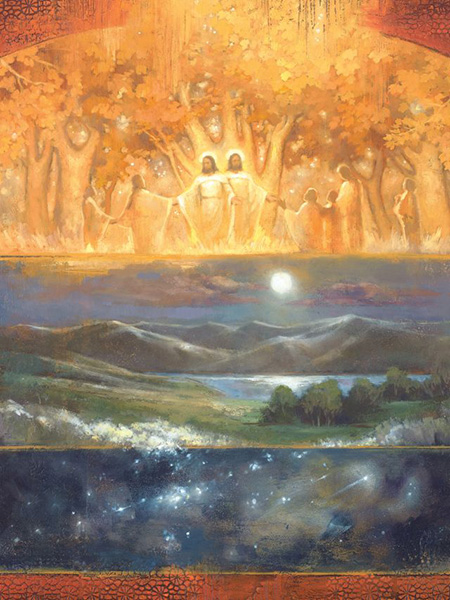
LDS understanding of the levels of Heaven and the afterlife. The top is the Celestial level, next the Terrestrial, and the lowest is Telestial. The Celestial is the brightest, represented by the sun, the Terrestrial by the moon, and the Telestial by the distant, faded light of the stars.
To return to The Book of Mormon, it seems that in very unusual circumstances, race or skin color can be changed:
And it came to pass that those [Indians] who had united with the Nephites [the Whites] were numbered among the [the Whites]; And their curse was taken from them, and their skin became white like unto the Nephites. And their young men and their daughters became exceedingly fair, and they were numbered among the Nephites, and were called Nephites. (3 Nephi 2:14)
The Book of Mormon also contains passages that more progressive members interpret as racially inclusive.
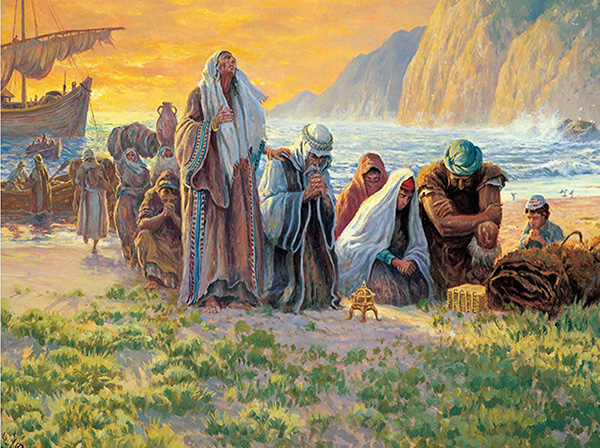
Arrival of the white-skinned pilgrims to the Western Hemisphere. They are thanking God for deliverance from potential destruction at the hands of the Babylonians.
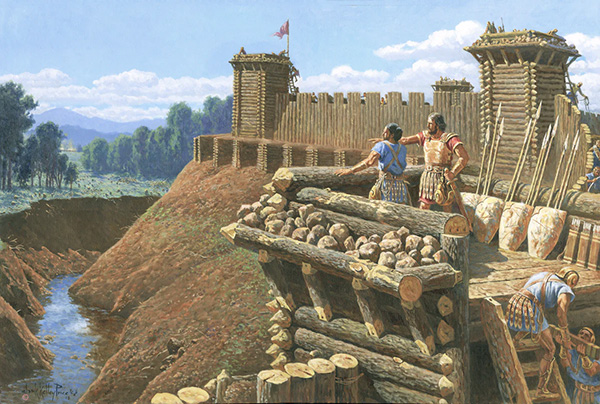
The white-skinned race (often referred to as Nephites) building cities and fortresses to defend against the dark-skinned race.
The following passage is from a sermon by a spiritual leader about the strife between the whites and the ancestors of Indians. He is correcting what he sees as improper conduct and unjust views held by the whites:
Behold, the Lamanites [Indians] your brethren, whom ye hate because of their filthiness and the cursing which hath come upon their skins, are more righteous than you; for they have not forgotten the commandment of the Lord . . . . O my brethren, I fear that unless ye shall repent of your sins that their skins will be whiter than yours, when ye shall be brought with them before the throne of God.
Wherefore, a commandment I give unto you, which is the word of God, that ye revile no more against them because of the darkness of their skins; neither shall ye revile against them because of their filthiness; but ye shall remember your own filthiness, and remember that their filthiness came because of [the sins of] their fathers. (Jacob 3:5,8,9)
Continuing in verse 20:
Do ye not suppose that such things [as pride, greed, and unchastity] are abominable unto him who created all flesh? And the one being is as precious in his sight as the other. And all flesh is of the dust; and for the selfsame end hath he created them, that they should keep his commandments and glorify him forever.
These passages do not deny the reality of race, but point out that God loves all races. There is a difference between having healthy racial boundaries and practicing racial hatred.
This passage is one of the most racially inclusive in The Book of Mormon:
None of these iniquities [essentially those forbidden in the Ten Commands] come of the Lord; for he doeth that which is good among the children of men; and he doeth nothing save it be plain unto the children of men; and he inviteth them all to come unto him and partake of his goodness; and he denieth none that come unto him, black and white, bond and free, male and female; and he remembereth the heathen; and all are alike unto God, both Jew and Gentile. (2 Nephi 26:33)
This is very similar to the passage in the book of Galatians in the Christian Bible, in which Paul writes to the Christians of his day: “There is neither Jew nor Gentile, bond nor free, male nor female, but all are one in Christ.” Progressive Christians consider this a divine revelation that race — or even, sometimes, sex — isn’t important, but that all distinctions have been done away with in Christ.
Both racially conscious Christians and Mormons interpret these passages as making a distinction between what is important to man and what is important to God; for men, sex, race, and slave status are crucial distinctions.
The significance of blood in LDS theology
The Pearl of Great Price contains the Book of Abraham. It refers to the “curse of Ham” — the idea that all descendants of Noah’s son Ham are cursed, and that his descendants were black. Until a change of doctrine in 1978, this passage justified excluding blacks from the LDS priesthood:
This king of Egypt was a descendant from the loins of Ham . . .
Thus, from Ham sprang that race which preserved the curse in the land. Pharaoh, being a righteous man, established his kingdom and judged his people wisely and justly all his days, seeking earnestly to imitate that order established by the fathers in the first generations, . . . who blessed him with the blessings of the earth and with the blessings of wisdom but cursed him as pertaining to the Priesthood. . . .
Pharaoh, being of that lineage by which he could not have the right of Priesthood, notwithstanding the Pharaohs would fain claim it from Noah through Ham . . . . (Abraham 1:21, 22, 27)
Egyptians were subject to the curse, even though they are not black Africans.
I once became acquainted with a Latter-day Saint military chaplain. He explained that the restriction on the priesthood wasn’t just about skin color. You could have people who didn’t look black at all, but if they had a drop of black blood, they would be under restriction. They could be members of the congregation through baptism, attend all the meetings, and join in communion (what Mormons call the sacrament), but they could not be ordained. Nor could they be married in a Mormon temple.
To be continued.

 By American Renaissance | Created at 2025-03-20 16:21:45 | Updated at 2025-04-05 12:10:44
2 weeks ago
By American Renaissance | Created at 2025-03-20 16:21:45 | Updated at 2025-04-05 12:10:44
2 weeks ago








